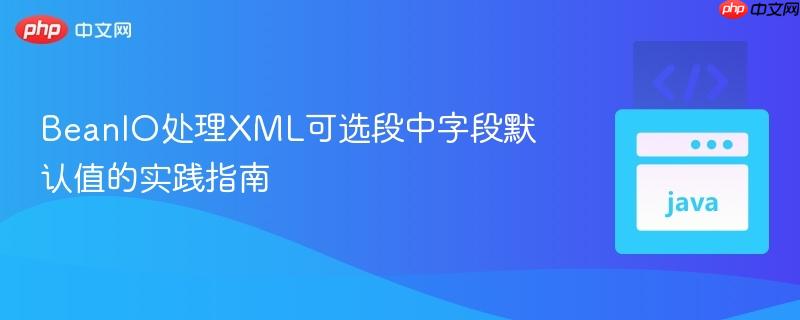
本文深入探讨了在beanio处理xml输入时,如何为可选段中的字段设置默认值,以避免在数据缺失时出现`null`值。文章提供了两种在java模型类中实现默认值的有效策略:通过字段初始化和在getter方法中处理,并强调了beanio映射文件中`xmlname`属性配置的重要性,确保数据解析的准确性。
在使用BeanIO解析XML文件时,如果XML结构中包含可选(minOccurs="0")的段(segment),并且该段在某些记录中完全缺失,那么BeanIO在映射到Java对象时,对应段中的字段将保持为null。尽管BeanIO提供了defaultValue属性用于字段映射,但此属性主要针对字段存在但内容为空的情况,对于整个可选段缺失导致字段根本未被解析的情况则不适用。为了在这种场景下为字段提供默认值而非null,我们需要在Java模型层进行处理。
考虑以下XML输入结构,其中<intern>段是可选的:
<students>
<student>
<name>Peter</name>
<intern>
<internLocation>Ohio</internLocation>
</intern>
</student>
<student>
<name>John</name>
</student>
</students>对应的BeanIO映射配置如下:
<beanio xmlns="http://www.beanio.org/2012/03">
<stream name="students" format="xml" strict="true">
<record name="student" class="com.testapp.model.Student">
<field name="studentName" xmlName="name" maxLength="20" />
<segment name="intern" minOccurs="0">
<!-- 注意:这里的xmlName="internLocation" 是正确的,原问题中存在错误 -->
<field name="internLocation" xmlName="internLocation" maxLength="50" minOccurs="0" default="" />
</segment>
</record>
</stream>
</beanio>以及Java模型类:
package com.testapp.model;
public class Student {
private String studentName;
private String internLocation; // 当<intern>段缺失时,此字段将为null
// Getters and Setters
public String getStudentName() {
return studentName;
}
public void setStudentName(String studentName) {
this.studentName = studentName;
}
public String getInternLocation() {
return internLocation;
}
public void setInternLocation(String internLocation) {
this.internLocation = internLocation;
}
@Override
public String toString() {
return "Student{" +
"studentName='" + studentName + '\'' +
", internLocation='" + internLocation + '\'' +
'}';
}
}在上述配置中,当解析到第二个<student>记录(John)时,由于没有<intern>段,internLocation字段在Student对象中将为null。
针对此问题,主要有两种在Java代码层面处理默认值的有效方法:
最直接的方法是在声明字段时为其赋予一个默认值。这样,即使BeanIO未能解析到该字段(因为整个可选段缺失),字段也已经有了初始值,而不会是null。
package com.testapp.model;
public class Student {
private String studentName;
private String internLocation = ""; // 直接初始化为空字符串作为默认值
// Getters and Setters
public String getStudentName() {
return studentName;
}
public void setStudentName(String studentName) {
this.studentName = studentName;
}
public String getInternLocation() {
return internLocation;
}
public void setInternLocation(String internLocation) {
this.internLocation = internLocation;
}
@Override
public String toString() {
return "Student{" +
"studentName='" + studentName + '\'' +
", internLocation='" + internLocation + '\'' +
'}';
}
}优点: 代码简洁,易于理解。字段在对象实例化时即拥有默认值。 缺点: 如果需要根据更复杂的逻辑来决定默认值,这种方式不够灵活。
另一种方法是在字段的getter方法中检查其是否为null,并返回一个预设的默认值。这样可以确保在任何访问该字段的地方都能得到一个非null的值。
package com.testapp.model;
public class Student {
private String studentName;
private String internLocation; // 保持默认null
// Getters and Setters
public String getStudentName() {
return studentName;
}
public void setStudentName(String studentName) {
this.studentName = studentName;
}
public String getInternLocation() {
// 如果internLocation为null,则返回空字符串,否则返回其本身
return internLocation == null ? "" : internLocation;
}
public void setInternLocation(String internLocation) {
this.internLocation = internLocation;
}
@Override
public String toString() {
return "Student{" +
"studentName='" + studentName + '\'' +
", internLocation='" + getInternLocation() + '\'' + // 注意这里调用了getter
'}';
}
}优点: 提供了更高的灵活性,可以在getter中实现复杂的默认值逻辑。字段的实际值仍然可以是null,这对于某些需要区分“未设置”和“空值”的场景可能有用。 缺点: 每次访问字段都需要通过getter,略微增加了代码量。在toString()或其他需要直接访问字段的地方,需要确保调用getter方法以获取默认值。
尽管BeanIO提供了强大的数据绑定能力,但在处理XML中可选段的默认值问题上,当整个段缺失时,其内置的defaultValue机制存在局限性。此时,最佳实践是将默认值逻辑转移到Java模型类中实现。通过字段初始化或在getter方法中进行null检查并返回默认值,可以有效地确保应用程序处理的数据始终具有预期的非null值,从而提高程序的健壮性和可预测性。同时,务必仔细核对BeanIO映射文件中xmlName等属性的配置,以确保XML数据能够被正确地解析和映射。
以上就是BeanIO处理XML可选段中字段默认值的实践指南的详细内容,更多请关注php中文网其它相关文章!

每个人都需要一台速度更快、更稳定的 PC。随着时间的推移,垃圾文件、旧注册表数据和不必要的后台进程会占用资源并降低性能。幸运的是,许多工具可以让 Windows 保持平稳运行。

Copyright 2014-2025 https://www.php.cn/ All Rights Reserved | php.cn | 湘ICP备2023035733号